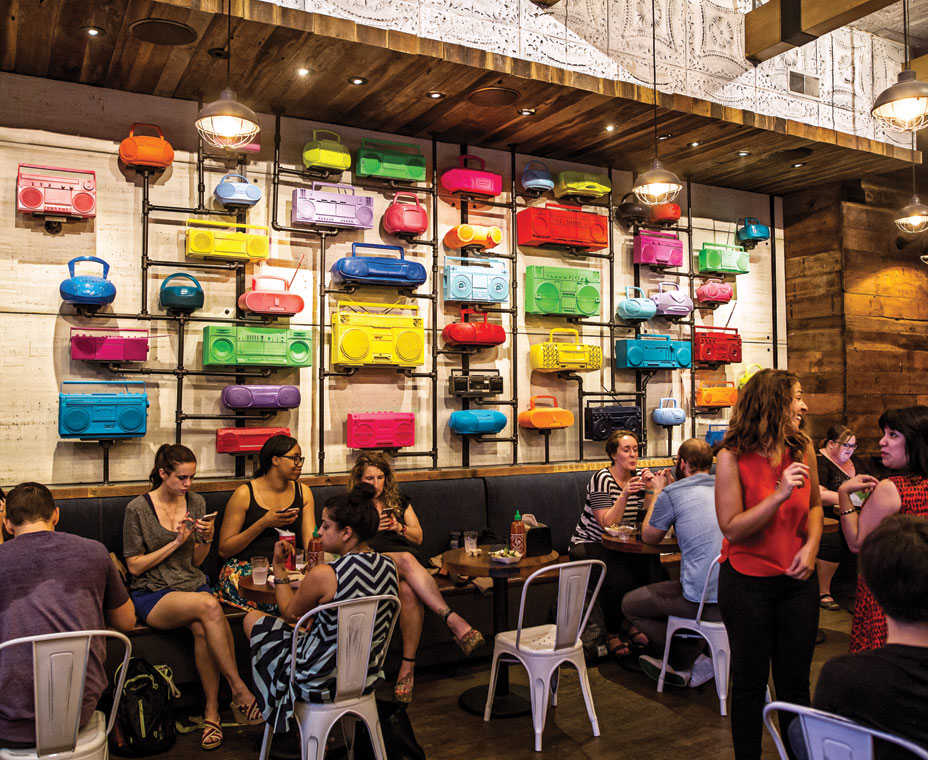From floor to ceiling, lighting to walls, and fixtures to furniture, interior design is pricy. Some restaurants, however, have found creative ways to curb those costs.
Design costs for the dining area of a restaurant can run $120–$300 per square foot or more depending on the desired look and feel. The luxury furniture and finishes expected in full-service, fine-dining restaurants generally have the highest price tags, but even décor components of limited-service restaurants can be pricy.
To get a handle on design, Washington, D.C.–based chain &pizza turns to design director Heidi Guerard, who says controlling costs is a matter of priorities. &pizza doesn’t spend much on ceilings and floors, choosing to simply polish the concrete below and paint everything black above rather than pay for ceiling or floor tiles. That industrial look frees up funds to invest on art murals for the walls. Design flexibility also helps the growing pizza chain save money.
“Every shop design is different,” Guerard says. “We don’t use all the same materials in every restaurant, which means we can play with new materials.”
One design experiment that paid off for &pizza was using tiles that cost $1.50 per square foot and cutting them at an angle instead of buying specialty tiles priced at $25 per square foot.
Seoul Taco is another rising chain that has developed clever hacks for saving money on design. Owner David Choi worked with Chicago’s SmartMouth Designs to evolve his St. Louis food-truck business into five stores spread across St. Louis; Columbia, Missouri; Champaign, Illinois; and Chicago. Choi says a typical restaurant might spend $125,000 on furnishings for a restaurant, but by using reclaimed items, Seoul Taco is able to furnish a restaurant for around $65,000.
One way Choi saves money is by combing through thrift stores for old boomboxes that are then spray-painted bright colors and used to decorate an entire wall inside every location. Since the business started as a food truck, Seoul Taco also repurposes pieces of old trucks as design elements. And behind the counter of every Seoul Taco, the wall is full of words in a variety of sizes, fonts, and languages. The words are cut out of plywood and painted.
“It’s fun to do, and it fits our atmosphere and vibe,” Choi says of the DIY decorating.
Choi says Seoul Taco’s Midwest base of operations ensures a supply of reclaimed barn wood to use on restaurant walls. Reclaimed bowling alley wood has been used for countertops.
There are some areas where both Choi and Guerard refuse to scrimp, and that’s tables and chairs, which constantly take a beating in a restaurant.
“We could save money with two-tops and four-tops, but for us that looks cluttered, so we choose to invest in durable commercial-grade community tables for &pizza,” Guerard says.
Seoul Taco tends to move into existing spaces rather than build restaurants, and Choi says if a space they take over has high-quality booths in place, they’ll save money by reupholstering rather than purchasing new ones.
“We go off what a location provides, which then gives us flexibility and not the same box model,” he says.
Being relatively small chains, &pizza and Seoul Taco are able to cut costs by designing stores individually. At a certain point in a concept’s growth trajectory, however, duplication from unit to unit saves money.
Jackson, Mississippi–based Newk’s Eatery, for example, has managed to cut construction costs by as much as $80,000 per store as they pursue the goal of 200 units by 2019.
Mike Snyder, Newk’s Eatery senior director of construction, says the key to cutting costs is to look at the entire construction budget line by line. Because Newk’s added 16 stores in 2017 and plans at least 20 more for 2018, most of the savings are the result of procuring materials in volume for multiple locations.
Instead of building cabinets on-site during construction, Newk’s orders them pre-built, pre-assembled, and pre-stained from a single supplier. It ensures a consistent look and shaves time off of the construction schedule. A single-source millwork vendor took $20,000 out of the construction budget for each new Newk’s store.
Snyder did find some design elements that are non-negotiable, but even these benefited from tweaks. For example, in reviewing the construction budget, Snyder learned that the door pulls Newk’s specified were a half-inch oversized for a standard door, so standard doors were being scrapped and new custom doors ordered. The door pulls were accordingly retooled, saving $14,000 per store.
Whether a restaurant has two locations or 200, owners must find clever ways to share their brand narratives while still saving money on design, says Chicago-based branding expert Adrienne Weiss.
Repurposing, Weiss says, is a consumer trend that has spilled over from home décor and been adopted by limited-service restaurants to cleverly save money on design.
“Every design decision should be viewed through a brand filter,” Weiss says. “If your brand is really quirky, then you get more latitude. Make sure the store design is consistent with the brand story you want to tell.”












